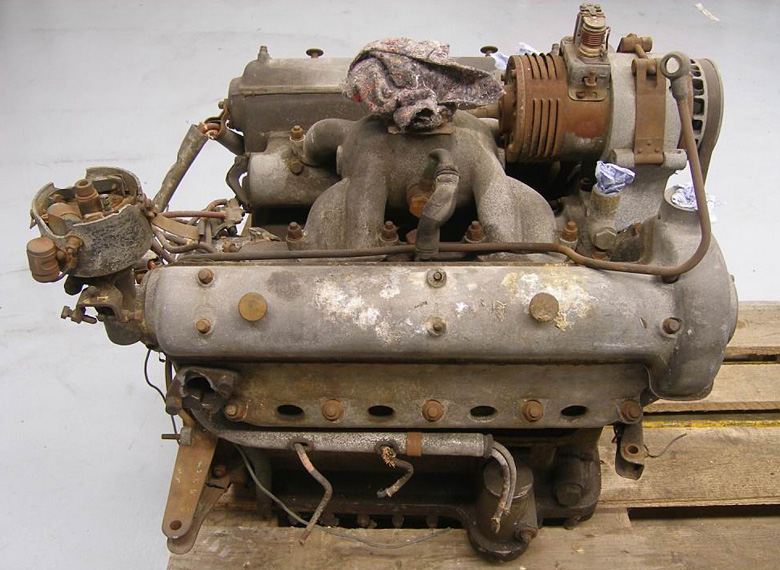
This picture of the engine as found sent David Smith on the journey that resulted in the Alfa S 11 project.
By Michael T. Lynch
Color photos courtesy David Smith
This article was originally published in 2012.
When the world’s automotive elite gather at Monterey, they bring an amazing array of machinery with them. VeloceToday is previewing two cars that will be present, one Italian and the other French. Both will be the subject of much controversy. Some will see then as logical completions of concepts that were interrupted by World War II, done to the highest standards. Others will opine that they are sacrilegious creations putting false Gods before us. One thing is for sure. Much fine wine will be downed discussing their merits and shortcomings. Both have revered nameplates. One is an Alfa Romeo and the other, a Bugatti.
This week we will begin with the Italian vehicle, with the Bugatti following in the next issue. The nomenclature for the Alfa, chosen by the owner David Smith, is a 1938 Alfa Romeo S 11 Corto Spyder Speciale.
It all began when David was offered an unusual Alfa engine by an Italian broker. It was pictured strapped to a pallet, rough with no accessories. David realized it was one of the three S 11 V-8s made in 1938. Despite the fact that he was told the engine was frozen and there was water on the oil dipstick, the purchase was completed.
Smith later heard that some on the vintage circuit thought he had bought a pig in a poke. However, when David got the engine home and took the flywheel off, there was pea gravel behind it. With the gravel removed, the engine turned freely. When disassembled, there was water in the bottom of the sump, but it had not done any damage because Alfa had prepared the engine meticulously for storage, using a cosomoline-like substance. This turned out to be engine No.2.
While it was never confirmed where the engine came from, Smith turned up pictures of other engines and parts in a storage area next to a pea gravel courtyard that was part of the Righini junkyard outside of Modena. Over the years, the Righini family has assembled one of finest car collections in the world. It numbers over 100 and includes the only surviving Auto Avio Costruzioni 815, conceded to be the first Ferrari, an Alfa 8C Monza and a Ferrari 312 T4 Grand Prix car.
It was in the Righini junkyard that a large array of vintage Alfa parts ended up when the company moved production from Portello to Arese in the early 1960s and Smith believes there is a strong possibility that the three S 11 engines ended their time with Alfa by going to Righini.
Now on a mission, Smith bought another of the single overhead camshaft S 11 engines from a collector in Germany. This was No.1 and when compared with Smith’s No.2, it was obvious that Alfa had been engaged in a development program. There was even a four camshaft V-8 planned for racing, but it was never built.
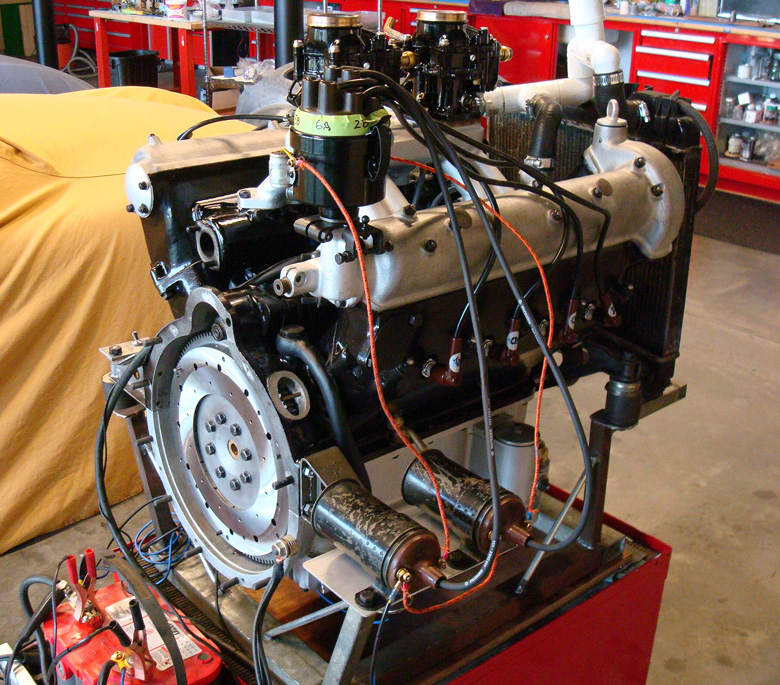
The engine is shown after restoration. The Weber 36 DCR carburetors are solid brass and were used on many pre-war Alfas, including the 12-cylinder single seaters.
No.1 had different heads, a different firing order, crankshaft, and many other details that had been changed in the construction of the second engine. No.2 had alternating cylinder liners, one steel, and then one cast iron. Both engines were fascinating in that the exhaust and intake ports were on the inside of the V, with a complex system of water jacketing. The second engine had the same firing order as an early Ford flathead V-8 as well as wedge shaped combustion chambers and siamesed ports just like the Ford. Despite Luigi Fusi’s definitive work, Alfa, Alfa Romeo, Tutte Le Vetture Dal 1910, giving the displacement as 2.3 liters, engine No.2 measured out at 2.5.
The No.2 engine is pictured in the Fusi book.
The 90 degree V-8 has a single overhead cam on each bank driven by a double chain that also drives the water pump. The engine is timed like two four cylinder engines and features twin coils and a single distributor. Within the distributor are two sets of points, two condensers and two rotors. The crankshaft bearings are babbit. All parts are signed and dated. The water pumps on both engines are stamped S 10, so are from another stillborn prototype, a sohc V-12, two of which were built. Both S 10 V-12s are in cars today.
Since most people, even many in the Alfa community, believe Alfa’s first V-8 was the engine for the Tipo 33/2 sports racing car of 1967, Smith had been thinking about how to share one of these historic artifacts with the public. He decided the best way to do that would be to put the engine in a running chassis so it could be seen on the road. The question was what chassis?
Since the engines were made in 1938, it would have to be a chassis from that period of Alfa’s history. David bought a 1938 6C 2300 B Series 2 Coupe Corto in Switzerland. The rear seat was removed and the engine was placed there. Then the car was locked in its own container and shipped to the U.S.
This would be the basis of Smith’s project. Not quite 200 of these 6C 2300 Corto chassis were made in 1938. They were similar in size, but with detail differences, to the 8C 2900 B chassis, using torsion bars instead of the swing axles on the larger displacement car.
The next decision was to decide on a body style for the chassis. Since Touring was making some Alfa bodies at this time, Smith reasoned that had production of the S 11 commenced, a wealthy sportsman might have commissioned a sporting open version of the S 11 that would have been similar to a Touring 8C 2900 B Corto Spyder. This concept would become the basis for his project.
A generous collector allowed Smith to loft his Touring-bodied 8C2900B Alfa roadster. Lofting, or free form surface modeling, is a computer aided design process whereby the shape of the body is captured in a digital three dimensional form. In Smith’s case, once the shape was defined, sections were created to form a plywood buck. The ribs were made by a computerized numerical control water jet that is capable of cutting metal. When the buck was done, it recreated the body shape accurately, but did not reflect the openings for the doors, hood, etc. At this point another, almost identical 8C 2900 B was offered so measurements of these openings could be taken and used to replicate the body exactly.
The next problem to be solved was a superstructure to support the body. The one on the 6C 2300 was obviously not applicable for the intended coachwork. Smith is not an EBay junkie, but he did find an offer of some 8C 2900 B engineering drawing on line. They were traced to Argentina and were copies of actual factory drawings of the chassis, engine, drive train and the superstructure. The process took another step forward.
From the beginning, Smith was determined to use all parts of the 2300 chassis, with only the body as a new component. A period factory exploded parts schematic publication showed that many parts were identical to an 8C 2900 B. These included hinges, door latches, the radiator and its shutters, gauges, the electrical system and even the wipers. All these were incorporated into the new 8C 2900 B body as well dash, cowl parts and Carello headlights that had been discarded in others’ 8C restorations. 1938 style Alfa fasteners were used throughout. The grill surround was formed on an old buck in Milan using brass as in the original.
The body was finished by Craig Wick’s Wicked Fabrication in Auburn, Washington. Adam Hart took the lead there on the project. Smith did the work on the engine, driveline and details in his shop. A significant problem was that the steering shaft would not clear the wider V-8 and had to be rerouted.
To diminish weight in order to offset the V-8s lack of both displacement and a supercharger, Smith’s car has a steel framework with a rolled on aluminum body. This makes the car much lighter than an 8C 2900 B, since almost all of the Spyders were fitted with steel bodies. The torsion bar rear suspension takes a set better than the swing axles on a 2900 and Smith says it is a joy to drive.
This gorgeous and impressive automobile is built to the highest standards and perfectly reflective of the period. David will be with the car when it is first show to the public at The Quail – A Motorsports Gathering on the Friday 17 August during Monterey’s automotive festival week. He’s looking forward to questions from the guests. From the looks of what we see here, there will be plenty of inquiries.
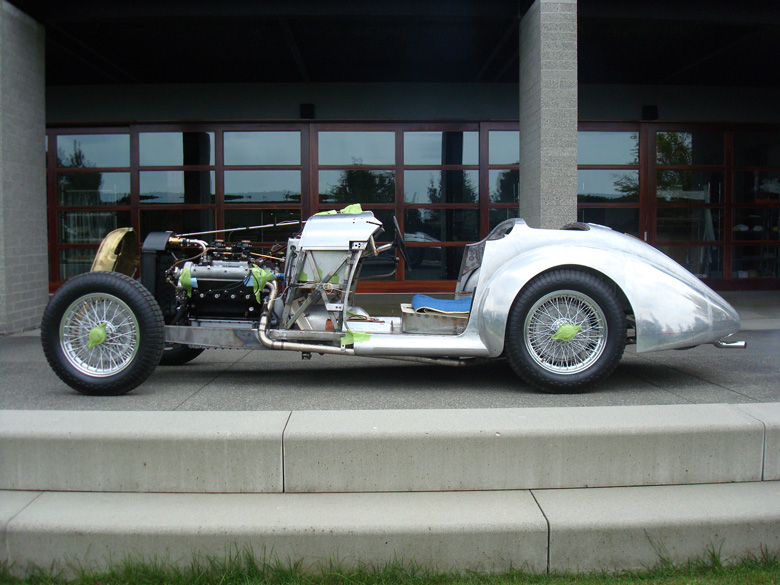
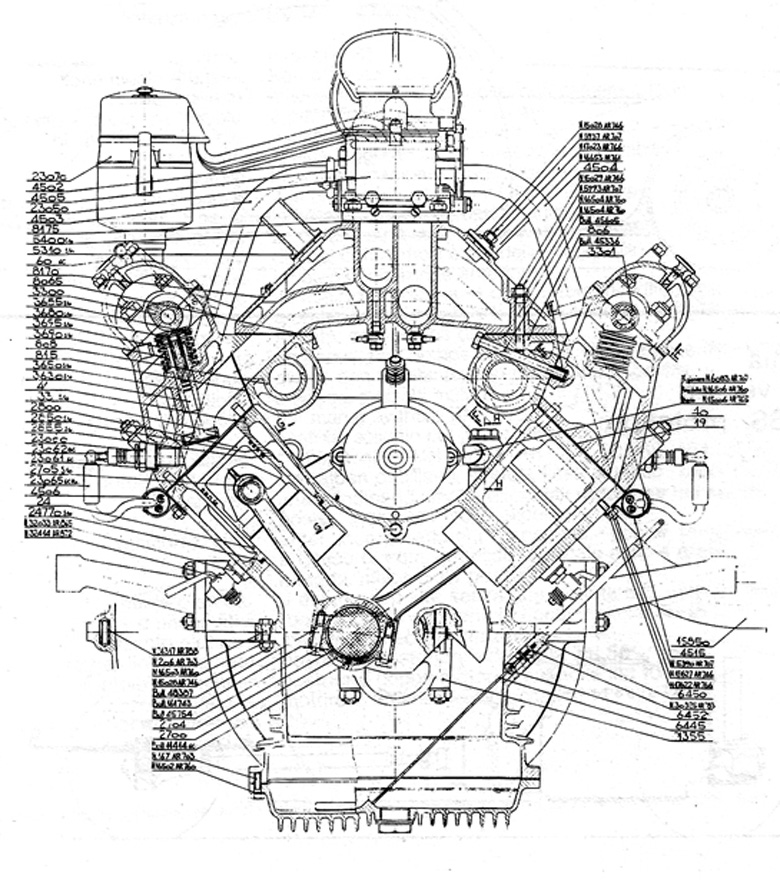
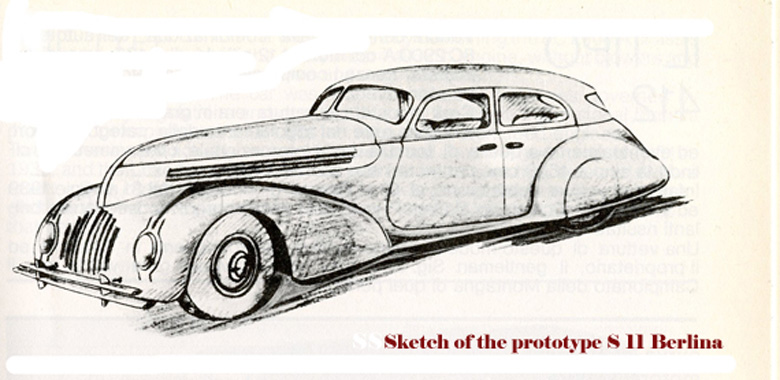
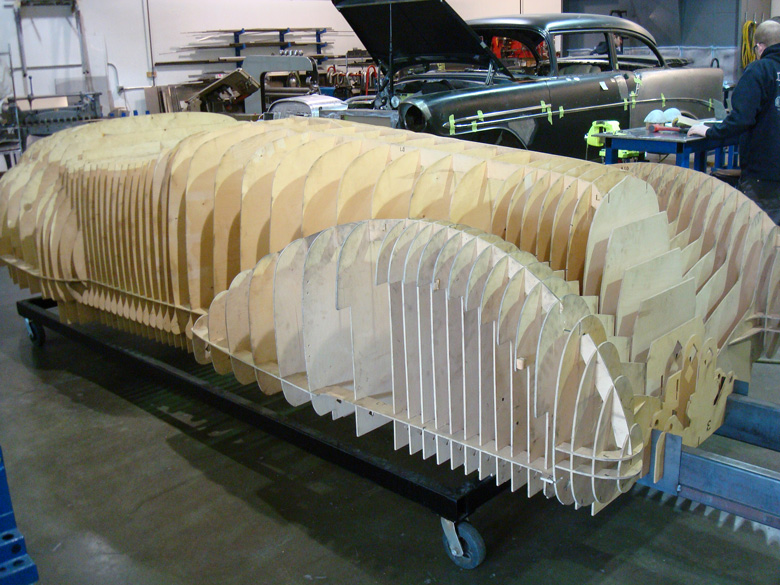
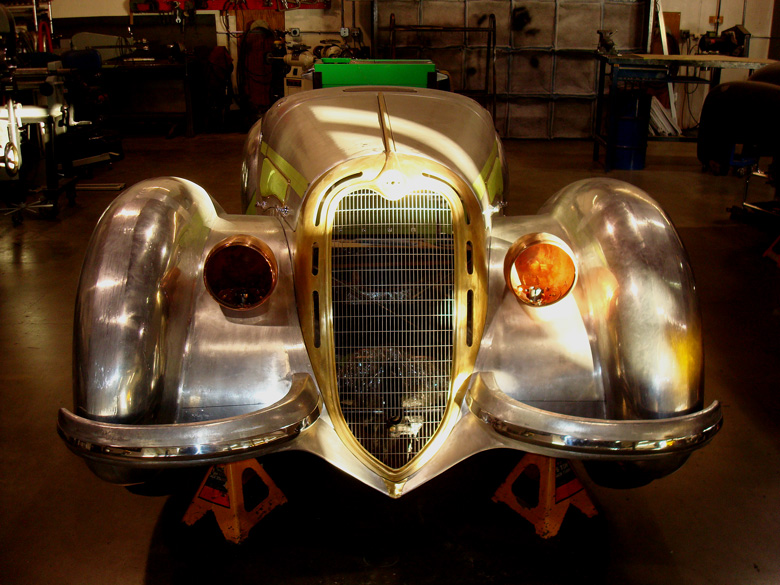
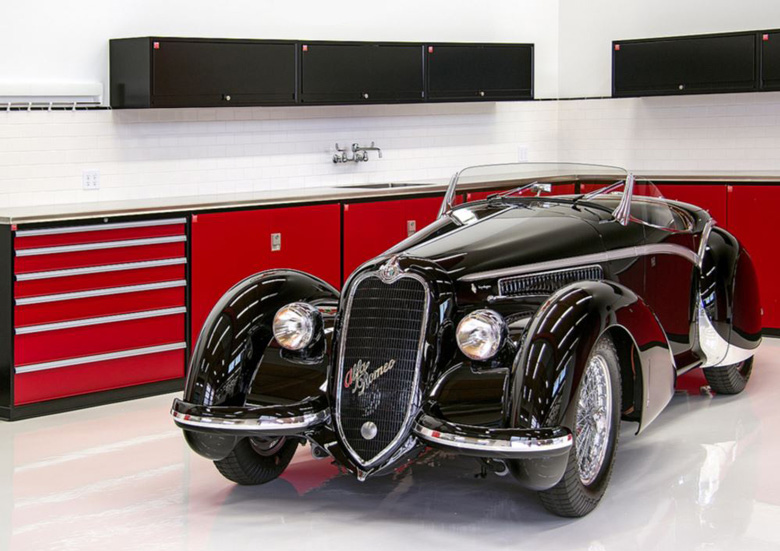
Will the car be shown anywhere else (other than the Quail) in Monterrey during the weekend?
Obviously not a restoration but a great place to display an original historic engine. Having a running period correct car for the engine to move around is way better than the engine sitting dead on a diplay stand. I am glad the owner had the money to spend on this project and am looking forward to seeing the car.
like wow.
i still prefer 4 cams & crossflow heads.
> jack
Kudos to Michael Lynch and David Smith. Great article on a great car. I know of few who are as meticulous and careful of facts as Michael and David, and thanks for bringing this piece of history to us.
How marvelous that there are still people with the wherewithall AND THE DESIRE to preserve and complete these automotive bits of history that could so easily be lost to the world! The “almosts” and “what ifs” are legion and most get lost to the dustbin of history.
Fascinating, perhaps it may be displayed at Goodwood FoS sometime?
My only caveat is that I think Alfa Romeo transferred production from Portello (not Portobello) to Arese in the ‘sixties.
I have a particular reason to be delighted that projects like this and the Mullin rebodied Bugatti are in the news. Right here in Virginia I’m working on a teardrop coupe rebody for an Alfa 6C2500SS, with the same guidelines: all the Alfa parts (chassis, engine, etc.) as original, new body with the same construction, materials, and design themes as the Italian coachbuilder would have used in 1947. I had the idea, and bought the Alfa parts, in 1975, but only now am within sight of completion. With just one worker–me–whacking at some metal in his shop, it takes longer than for these highly paid teams. Pictures on request.
The authors get confused with making a difference with a swing axle and torsion bar suspension since Auto Union GP Cars types A, B and C, all VW beetles and most of Porsche 356s have torsion bar sprung rear swing axle suspension.
Regards
Martin Schoeder
Great article.
The term for gathering form volumetric information is ‘Taking Lines’ or Lines Taking’. You would then loft the lines with that information to create ‘Station’ line sections to create the ‘Buck’ or ‘Mold’.
Cadillac flat head V-8’s used the same intake and exhaust arrangement. It went in to production in 1936.
Kudos to David for this inspired effort, we are all winners due to those efforts.
Regards and Thanks …..A Knesal
http://en.wikipedia.org/wiki/Cadillac_V8_engine
http://www.google.com/imgres?imgurl=http://farm4.static.flickr.com/3393/3656696988_3a631e17b3_o.jpg&imgrefurl=http://www.bullsac.com/2009/07/12/cadillac-346-flathead-v8/&h=411&w=589&sz=33&tbnid=Q3Y60E8I5y_QgM:&tbnh=92&tbnw=132&zoom=1&usg=__tm7Jj1EsydyhiBU3a5EZq5G34mY=&docid=oTXQy5P65jwFOM&hl=en&sa=X&ei=LGcRUM2zHcWEjAK0oYGoCw&sqi=2&ved=0CFAQ9QEwAg&dur=5528
Mr. Macnab is, of course, completely correct. Portello is not Portobello, I must have gone directly from the kitchen to the keyboard.
It’s great to see these engineering “dead ends” brought back to life. Some time ago I read that some one had purchased a big pile of old experimental parts from Ferrari and among them was a complete vertical twin engine! That’s the one I want to see and hear!
Michael, Very nice article – great to keep these oldies stories on the front pages.
David, Great that you had the vision, enthusiasm and resources to do all this.
No question that thes early European cars take the cake…..
Robert Blair.
Mr. Collins,
The car will only be shown at The Quail this year.
Mr. Schroeder,
To clarify my comments re the rear suspension. The 8C 2900 Bs have a transverse leaf spring swing axle. It is generally accepted that such a setup transfers loads from one side to the other, sometimes upsetting the opposite wheel from the one whose suspension is being compressed.
The featured car has the rear suspension located by torsion bars. This prevents the situation outlined above. To make this work on the cited speciale, both the trailing arms and the half shafts had to be lengthened. BTW, both front and rear suspensions in these period Alfas ride in needle bearings, contributing to their legendary handling.
As a historian, and an Italophile, the construction of the historical context was fascinating. Much of the technical info is beyond me, but I was intrigued by the research involved in the process. An evocative article that has generated an abundance of high-quality commentary is proof of an interesting endeavor. Kudos to all.
Bob Lemon, Ph.D.
Retired prof
A friend of mine,Georg Leitl is restoring an identical Alfa here in Melbourne, Australia—his email is gleitl@bigpond.net.au
Michael, Great research and article……